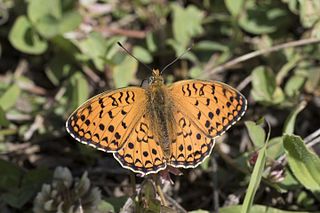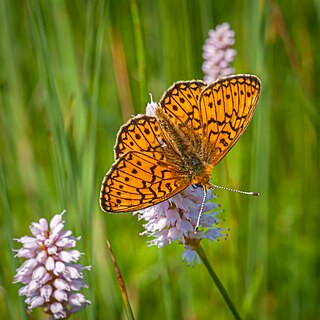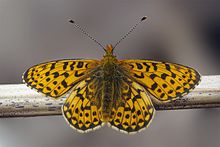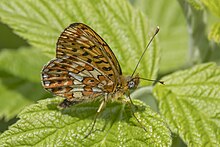
The silver-washed fritillary is a common and variable butterfly found over much of the Palearctic realm – Algeria, Europe and across the Palearctic to Japan.

Boloria selene, known in Europe as the small pearl-bordered fritillary and in North America as the silver-bordered fritillary, is a species of butterfly of the family Nymphalidae. It is found across Europe, Asia and North America, and feeds exclusively on violets in its larval stages. This species prefers wet grassland habitats, where its larval food source, violets, are found. It overwinters in its larval stage, and eggs hatch in the late summer to early autumn. Members of this species are prey for multiple types of birds and other insects.

Fabriciana adippe, the high brown fritillary, is a large and brightly colored butterfly of the family Nymphalidae, native to Europe and across the Palearctic to Japan. It is known for being Great Britain's most threatened butterfly and is listed as a vulnerable species under the Wildlife and Countryside Act 1981. Like other fritillaries it is dependent on warm climates with violet-rich flora.

The dark green fritillary is a species of butterfly in the family Nymphalidae. The insect has a wide range in the Palearctic realm - Europe, Morocco, Iran, Siberia, Central Asia, China, Korea, and Japan.

The Niobe fritillary is a species of butterfly in the family Nymphalidae.

Lambert's Castle is an Iron Age hillfort in the county of Dorset in southwest England. Since 1981 it has been designated as a Site of Special Scientific Interest (SSSI) on account of its geology, archaeology and ecology. The hillfort is designated a scheduled monument together with a bowl barrow, the sites of a post-medieval fair and a telegraph station. The site was on the Heritage at Risk Register but was removed in 2022 as a result of the Hillforts and Habitats Project.

Boloria is a brush-footed butterfly (Nymphalidae) genus. Clossiana is usually included with it nowadays, though some authors still consider it distinct and it seems to warrant recognition as a subgenus at least.

The scarce fritillary is a species of butterfly in the family Nymphalidae. It is found in Austria, Bulgaria, Czech Republic, Finland, France, Germany, Greece, Hungary, Kazakhstan, Lithuania, Luxembourg, Poland, Romania, Russia, Serbia and Montenegro, and Sweden. and East across the Palearctic to Mongolia.

Boloria chariclea, the Arctic fritillary or purplish fritillary, is a butterfly of the family Nymphalidae. It is found in the northern parts of the Palearctic and Nearctic realms.

Boloria dia, the Weaver's fritillary or violet fritillary, is a butterfly in the family Nymphalidae. The name Weaver's fritillary is in honor of Richard Weaver, an English insect collector who claimed to have obtained the specimen within ten miles of Birmingham around 1820. However, B. dia is very rare in England and the few specimens known from there are thought to be from possibly accidental introductions.

Boloria eunomia, the bog fritillary or ocellate bog fritillary is a butterfly of the family Nymphalidae.

Boloria titania, the Titania's fritillary or purple bog fritillary, is a butterfly of the subfamily Heliconiinae of the family Nymphalidae.

Melitaea didyma, the spotted fritillary or red-band fritillary, is a Palearctic butterfly of the family Nymphalidae.

Boloria bellona, the meadow fritillary, is a North American butterfly in the brushfoot family, Nymphalidae. The common name, meadow fritillary, is also used for a European butterfly species, Melitaea parthenoides.

Boloria polaris, the Polaris fritillary, is a butterfly of the family Nymphalidae. It is found in northernmost Scandinavia, North America and in Greenland. It is also found in northeastern Russia and across the Palearctic to Chukotka. It is one of only six butterfly species found on Canada's Ellesmere Island.

Boloria pales, the shepherd's fritillary, is a butterfly of the family Nymphalidae. It is found from the Cantabrian Mountains and the Pyrenees through the Alps and Apennine Mountains east to the Balkan, Carpathian Mountains, the Caucasus and central Asia up to western China.

The twin-spot fritillary is a butterfly in the family Nymphalidae.

Boloria selenis is a species of butterfly in the family Nymphalidae. It is found from the Volga basin to Japan.























